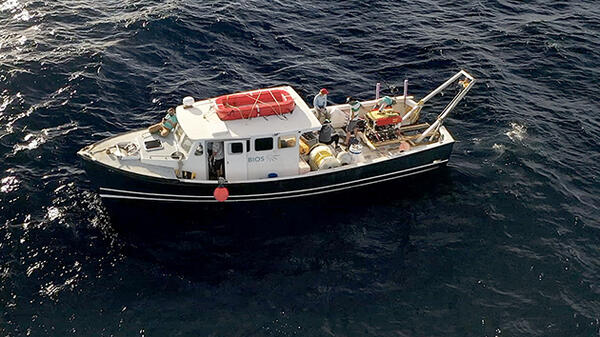Twenty-five teams from 12 Bermuda schools and educational organizations will converge on the National Sports Centre on Saturday, April 22, for the 2017 MATE Bermuda Regional Remotely Operated Vehicle (ROV) Challenge. The program, hosted by BIOS, is part of the Mid-Atlantic Robotics IN Education Program (MARINE), with lead donor support from HSBC.
Bermudian Students to Gather for BIOS’s Remotely Operated Vehicle (ROV) Challenge
April 13, 2017

They Came. They Saw. They Brought Robots.
May 13, 2017

The pool at the National Sports Centre hosts numerous aquatic competitions throughout the year, but perhaps none as unique as the MATE Bermuda Regional Challenge. The annual challenge, organized by BIOS’s Ocean Academy and supported by lead donor HSBC, is the culmination of months of work by teams of students on the design, construction, and operation of remotely operated vehicles, or ROVs. The challenge is also the final event in the BIOS Mid-Atlantic Robotics IN Education (MARINE) program, which uses a focus on marine robotics to bring science and technology curricula into classrooms around the island.
Registration Now Open for the 2016 Remotely Operated Vehicle (ROV) Challenge
October 27, 2015

Registration opened Oct. 1 for middle school team participation in the popular Remotely Operated Vehicle (ROV) Challenge, sponsored by the Mid Atlantic Robotics IN Education (MARINE) program. This year’s program, hosted by BIOS, will become a regional partner with the Marine Advanced Technology Education Center (MATE), which challenges students to apply physics, math, electronics, and engineering lessons to the marine environment.
BIOS Volunteers Needed for Underwater Robotics Competition
February 04, 2016

Like to snorkel? Interested in supporting emerging marine engineers? Volunteers from BIOS and the Bermuda community are needed to assist on Saturday, April 30th as 33 teams of middle school students test their mission-tasked Remotely Operated Vehicles (ROVs) during an island-wide robotics challenge.
Gliders Return to Action
February 20, 2021

After a year of shark attacks, leaking instruments, and a hiatus resulting from the global COVID-19 pandemic, BIOS’s gliders are back to work in the waters offshore Bermuda.
On a Quest for Quiet
January 30, 2021

Oceanographer and ocean engineer Brennan Phillips runs the Undersea Robotics and Imaging Laboratory at the University of Rhode Island (URI) in Kingston, Rhode Island, where he and his students specialize in creating novel systems for oceanographic research and deep-sea exploration. He is also a familiar face at BIOS, having spent time at the Institute in 2019 testing the development of a controllable, miniaturized camera system for deep-sea exploration, called DEEPi.
A Sky-High Survey of Coral Reefs
November 30, 2015

NASA’s Earth Venture Suborbital-2 Program has awarded BIOS scientist Dr. Eric Hochberg a grant to initiate the COral Reef Airborne Laboratory (CORAL). The three-year project will use an instrument mounted within the belly of an airplane to survey reefs around the world. By using airborne data to calculate the amount of coral present on a reef, and to assess the processes underpinning coral reef growth or decline, CORAL provides a new and unprecedented perspective on coral reef ecosystems.
BIOS Explorer 2012: Gizmos and Gadgets to Study the Ocean
February 26, 2012

Read more here.
The Science Behind Successful Sailboat Racing
July 29, 2020

After the successful inaugural episode of Ocean Diaries—a virtual education program and collaboration that aired as a Facebook Live event on the Bermuda Aquarium, Museum, and Zoo (BAMZ) Facebook page last month to over 2,000 views—the team of educators at BAMZ, the Bermuda Zoological Society (BZS), BIOS, and the Bermuda Underwater Exploration Institute (BUEI) quickly remobilized to begin working on episode 2.
Ocean Rendezvous Rescues Research Project
December 20, 2012

Ruth Curry, Senior Research Specialist at Woods Hole Oceanographic Institution (WHOI), is used to the challenges that come with deep-ocean research; after all, she has spent the last three decades measuring circulation pathways in the Atlantic Ocean. But she never expected that, on a calm day in November, she’d require the help of two ships and an underwater robot to literally save her research program, an undertaking she describes as, “the most exciting thing I’ve done in my 32 years of going to sea.”